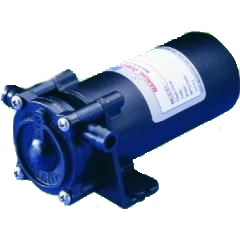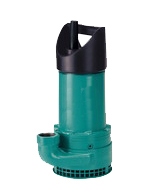Irrigation pumps are put into categories based on their design. The following are the most common types of irrigation pumps:
 Displacement Pumps- These pumps move water by displacement. Examples are piston pumps, diaphragm pumps, roller-tubes, and rotary pumps. Piston Displacement Pumps are pumps you operate by moving a long lever up and down. Usage for a displacement pump would be when you need to move very thick liquids, create very precise flow volumes, or create extremely high pressures. A fertilizer injector is the most common irrigation use for a displacement pump.
Displacement Pumps- These pumps move water by displacement. Examples are piston pumps, diaphragm pumps, roller-tubes, and rotary pumps. Piston Displacement Pumps are pumps you operate by moving a long lever up and down. Usage for a displacement pump would be when you need to move very thick liquids, create very precise flow volumes, or create extremely high pressures. A fertilizer injector is the most common irrigation use for a displacement pump.
Centrifugal Pumps- A vast majority of all irrigation pumps fall into this category.  This particular pump uses an impeller (rotating part that transmits motion in a device) which spins the water rapidly in a casing, chamber, or housing.The spinningaction is known as centrifugal force.This force isresponsible for moving the water through the pump. These pumps may have several stages which the water passes through the different stages increasing pressure. These pumps must have water in the intake pipe and the casing before starting the pump. It is imperative that youprime these pumps before the first use. This is done by filling the case with water, then quickly turning the pump on. This pump sucks water not air so you must have water in the pump to enable the water to move into the pump. You don’t have to prime the pump before every usage because it has a small valve that holds the water.
This particular pump uses an impeller (rotating part that transmits motion in a device) which spins the water rapidly in a casing, chamber, or housing.The spinningaction is known as centrifugal force.This force isresponsible for moving the water through the pump. These pumps may have several stages which the water passes through the different stages increasing pressure. These pumps must have water in the intake pipe and the casing before starting the pump. It is imperative that youprime these pumps before the first use. This is done by filling the case with water, then quickly turning the pump on. This pump sucks water not air so you must have water in the pump to enable the water to move into the pump. You don’t have to prime the pump before every usage because it has a small valve that holds the water.
End Suction Centrifugal pumps are different because they are designed to force water out verses forcing water in. the pumps work the best when the water level is higher than the pump verses lower. These pumps perform the best at pushing water.
 Submersible Pumps - Pumps that are completely installed under water. These are a single unit with a pump and electric motor. The main purpose is to be installed in a well but they can be installed on the bottom of a lake or stream if placed on their side or mounted to a pier. No need to prime these pumps due to them already being under water. If they aren’t installed in a well they need to be placed into a special pump and this may be necessary when placed into a well. The sleeve helps to keep the motor cool by moving the water flow over the motor. The pump would burn up without the sleeve. Since the power cord runs down to the pump it is extremely important to take safety precautions to prevent damage. Boats, alligators, and debris are common examples of possible hazards to your power cord.
Submersible Pumps - Pumps that are completely installed under water. These are a single unit with a pump and electric motor. The main purpose is to be installed in a well but they can be installed on the bottom of a lake or stream if placed on their side or mounted to a pier. No need to prime these pumps due to them already being under water. If they aren’t installed in a well they need to be placed into a special pump and this may be necessary when placed into a well. The sleeve helps to keep the motor cool by moving the water flow over the motor. The pump would burn up without the sleeve. Since the power cord runs down to the pump it is extremely important to take safety precautions to prevent damage. Boats, alligators, and debris are common examples of possible hazards to your power cord.
 Turbines and Jet Pumps - A centrifugal pump that is mounted underwater and attached by a shaft to a motor mounted above ground. The motor turns the shaft which causes the impeller to turn inside the pump. Jet Pumps are similar to the Turbines except they help lift the water by directing the down the intake. Turbine pumps are used a lot in irrigation because they are efficient and able to generate high water pressure.
Turbines and Jet Pumps - A centrifugal pump that is mounted underwater and attached by a shaft to a motor mounted above ground. The motor turns the shaft which causes the impeller to turn inside the pump. Jet Pumps are similar to the Turbines except they help lift the water by directing the down the intake. Turbine pumps are used a lot in irrigation because they are efficient and able to generate high water pressure.

Booster Pumps - Booster pumps are different from other pumps because they don’t take water from a non-pressurized source and move it to another location instead they are used to increase the water pressure of water that is already on its way somewhere. These pumps are used to boost the water pressure.

Floating Pump - Submersible or Floating pump that is attached to the bottom of a float. The pump is underneath the float which is anchored to a river, pond, or lake. These pumps are usually more energy efficient and easier to install than the other submersible pumps in a pond or lake.

Jet Pump - A jet pump is a self contained unit. Most commonly used as a deep well pump, this pump is simply dropped into a well with just a power cord and a water line. Because this well is deep beneath the water it is almost silent.